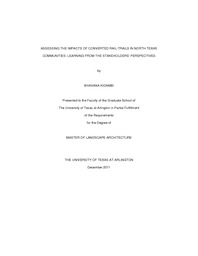| dc.description.abstract | Converting abandoned rail lines to trails is a strategy to enhance green infrastructure and provide recreational amenities for large metropolitan area dwellers. Literature on rail to trail conversions emphasizes several factors that influence this change. Some of the factors listed are environment, transportation, recreation, economy, historic preservation, community identity, health and wellness, conservation, livability and revitalization (Trails, 2005-2011; Conservancy, 2007; & Connecticut, 2011). The purpose of this research is to evaluate the stakeholders' perspectives on the impacts of rail-trails in North Texas on five recurring themes in the literature: environmental, recreational, transportation, health and wellness and historic preservation identified as potential areas of benefits. The research question of this study is two-fold. First, the research focuses on these factors based on all six converted rail-trails listed by the Rail-to-Trail Conservancy program in North Texas from the point of view of the stakeholders. Second, the research focuses on the impact of design on the six rail-trails. This research also examines the stakeholders views on the Rail-to-Trail Conservancy program in North Texas based on the trails. For the purpose of this research, systematic interviews and passive observations are conducted on six converted rail-trails, adopted by the Rails-to-Trails Conservancy program in the North Texas region. They are Chaparral Rail Trail, Denton Branch Rail Trail, Katy Trail, Katy Spur Trail, Lake Mineral Wells State Trailway and Waxahachie Hike and Bike Trail. Systematic interviews are conducted with stakeholders'. Three sets of stakeholders are identified: represented from the public sector who are with the cities and municipalities where the trails are located and knowledgeable about the trail; design or planning professionals who participated in the master planning of the rail to trail conversions or have a knowledge of the design criteria of the trails; and neighborhood association leaders to represent user's view on the trails. The data from the interviews are first transcribed and the interviews are then analyzed using data triangulation (Bogdan, 1982). Passive observations are done in the form of site visits by the researcher to in order to gain better knowledge of the sites under investigation. The findings of the research reveal that although each of the five factors assessed weigh differently, the stakeholders all affirm the positive impacts of rail-trail conversions in North Texas. Study also reveals, that while rail-trails may have specific tribulations, stakeholders value the adaptation and point out that the benefits to the environment outweigh the problems. Historic preservation and design being the primary point of consideration while environment and recreation are considered as default. Considering that more than 150,000 miles of tracks were abandoned and the number are increasing in US (Montage, 1989) it is critical for landscape architects to assess these conversions to improve green infrastructure and create spaces that serve people. | en_US |


